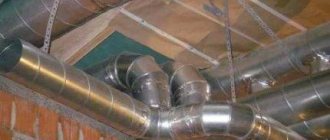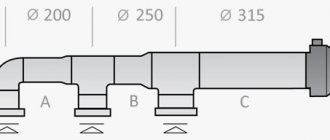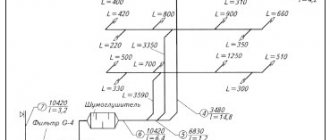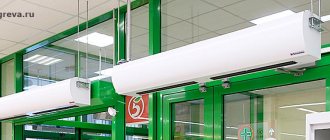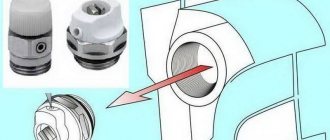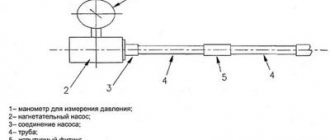The two main characteristics of industrial fans are pressure and performance. They describe the working fluid, that is, the medium transported by the fan. These are the main characteristics of centrifugal fans (radial fans) and vortex fans.
Other technical characteristics of the fan that are important for selection are its type, housing and impeller material, housing position, motor power (measured in kilowatts kW), drive type, efficiency, permissible temperatures and environmental conditions, permissible temperatures and composition of the transported medium, and also, if necessary, special designs and additional equipment.
Fan pressure
By industrial fan pressure we mean the total pressure difference between the pressure and suction of the fan, which consists of a static and dynamic component. Static pressure is created by the fan due to compression or rarefaction of the working fluid. Dynamic pressure is created by the kinetic energy of the working fluid flow.
The most commonly used pressure units are pascal - Pa (Pa) and its derivative kilopascal kPa (kPa), as well as millibar mbar (mbar) = 100 Pa.
Basic fan parameters
Date added: 2014-07-19 | Views: 2925Axial and centrifugal fans | Next page ==> Fan operation on the network
Fans, like pumps, are characterized by the following parameters:
performance;
pressure;
power;
efficiency
.
Fan performance
– this is the volumetric amount of gas supplied by the fan per unit time, expressed in m3/s.
The total pressure generated by the fan when supplying gas.
For ventilation machines, total pressure refers to the increase in pressure created by the fan. The total pressure is designated by the letter “P” and has the dimension Pa (as a reminder: in the “Hydraulics” section, the total pressure is understood as the specific mechanical energy of the flow with a geometric dimension of meter).
The total pressure created by the fan is considered as the sum of the pressures created during the operation of the machine to move gases. The sum consists of two terms: static pressure and dynamic pressure:
. (7.1)
Static pressure consists of two components: vacuum in the suction line and excess pressure in the discharge line.
In turn, the dynamic pressure, in accordance with the Bernoulli equation, is equal to the velocity pressure at the discharge pipe:
. (7.2)
Thus, the total pressure developed by the fan consists of three terms:
. (7.3)
In equation (7.3), the first term on the right side (rarefaction pressure) is always taken as a positive value, although in its physical meaning it is negative.
In Fig. 7.7 presents options for using static pressure created by machines for moving gases.
If the ventilation unit has suction and discharge lines (Fig. 7.7, a
), That:
.
If there is no suction line (air is taken directly from the atmosphere), then in accordance with Fig. 7.7, b
:
.
If there is no discharge line (air is discharged directly into the atmosphere), then, in accordance with Fig. 7.7, in
:
.
If there are no discharge and suction lines (non-pressure fan), then the total pressure is determined from the equation:
.
Rice. 7.7. Ways to use static pressure of fans:
A)
suction-discharge fan;
b)
blower fan;
V)
suction (exhaust) fan;
d)
free-flow fan
The power consumed by the ventilation unit is determined by the equation:
, (7.4)
where is the fan performance, m3/s;
– pressure increase created by the fan, Pa;
– overall efficiency of the ventilation unit, equal to:
. (7.5)
In equation (7.5), the factors on the right side of the equation are: – fan efficiency; – transmission efficiency; – engine efficiency.
For actually operating ventilation units, the overall efficiency lies in the range of 0.4 – 0.6.
| | | | | | | | | | | | | | | | | | | | | | | 24 | | | | | | | | | | | | | | | | | | | | | | | | | | | | | | | | | | | |
The free pressure of the fan is
Pressure is one of the main characteristics of a fan, which shows how the pressure of the air flow changes before and after the fan. It is due to this pressure that the air is “pushed” through a network of air ducts, turns, tees, grilles and other ventilation equipment.
There are static, dynamic and total fan pressures.
The air after the fan has a higher pressure than before the fan. The difference in air pressure is the static pressure of the fan (static pressure of the fan).
In addition, after the fan, the air acquires a certain speed of movement - the so-called velocity pressure . If you put a wall in the path of the air, then, obviously, upon reaching the wall, the air will stop, while slightly compressing. Near the wall, the kinetic energy of the air (velocity) will turn into potential energy (pressure). It is this increase in pressure that is the speed pressure of the fan. In other words, the dynamic pressure of a fan is the pressure that a moving air stream would have if it were suddenly stopped.
The total fan pressure is the sum of the static and dynamic pressure of the fan.
The pressure (pressure) of the fan depends on its design. Axial fans are the least pressure ones. Their pressure is measured in units and tens of pascals.
Medium-pressure fans are usually radial and centrifugal fans. Such fans “give out” hundreds of pascals. These fans are most often used in general ventilation systems.
High-pressure fans create pressure measured in thousands of pascals. Such fans are used in industrial ventilation systems for pumping air through long air ducts, used as smoke exhausters, and also for inflating when burning fuel.
A slightly different classification of fans is adopted in duct air conditioners. Duct air conditioners also come in low, medium and high pressure. The higher the pressure of the air conditioner, the more extensive the network of air ducts can be connected to it.
It is not recommended to connect air ducts to low-pressure air conditioners.
They are equipped with suction and discharge adapters, which have holes for suction and discharge of air. Medium-pressure duct air conditioners provide for the connection of air ducts of medium length. Usually we are talking about sleeves several meters long. Finally, high-pressure duct air conditioners are capable of pumping air 10 meters or more.
Pressure is one of the main characteristics of a fan, which shows how the pressure of the air flow changes before and after the fan. It is due to this pressure that the air is “pushed” through a network of air ducts, turns, tees, grilles and other ventilation equipment.
There are static, dynamic and total fan pressures.
The air after the fan has a higher pressure than before the fan. The difference in air pressure is the static pressure of the fan (static pressure of the fan).
In addition, after the fan, the air acquires a certain speed of movement - the so-called velocity pressure . If you put a wall in the path of the air, then, obviously, upon reaching the wall, the air will stop, while slightly compressing. Near the wall, the kinetic energy of the air (velocity) will turn into potential energy (pressure). It is this increase in pressure that is the speed pressure of the fan. In other words, the dynamic pressure of a fan is the pressure that a moving air stream would have if it were suddenly stopped.
The total fan pressure is the sum of the static and dynamic pressure of the fan.
The pressure (pressure) of the fan depends on its design. Axial fans are the least pressure ones. Their pressure is measured in units and tens of pascals.
Medium-pressure fans are usually radial and centrifugal fans. Such fans “give out” hundreds of pascals. These fans are most often used in general ventilation systems.
High-pressure fans create pressure measured in thousands of pascals. Such fans are used in industrial ventilation systems for pumping air through long air ducts, used as smoke exhausters, and also for inflating when burning fuel.
A slightly different classification of fans is adopted in duct air conditioners. Duct air conditioners also come in low, medium and high pressure. The higher the pressure of the air conditioner, the more extensive the network of air ducts can be connected to it.
It is not recommended to connect air ducts to low-pressure air conditioners.
They are equipped with suction and discharge adapters, which have holes for suction and discharge of air. Medium-pressure duct air conditioners provide for the connection of air ducts of medium length. Usually we are talking about sleeves several meters long. Finally, high-pressure duct air conditioners are capable of pumping air 10 meters or more.
Pressure loss in axial fans
1. Profile losses. As in radial fans, profile losses depend on the angle of attack on the blades. At the current radius r, the angle of attack on the wheel blades is determined by the formula: a1 = ?G – ?1 – f1.
In the design mode (in some cases coinciding with the mode of maximum total efficiency), the angle of attack, as a rule, is equal to the optimal one: a1 = a1opt, while the profile losses are minimal or close to them. As the fan performance (axial speed ca) increases relative to the calculated angle of attack a1 on the blades, they decrease and become negative, which leads to a cross-section of profile losses. As productivity decreases relative to the design value, the angles of attack on the blades increase, which leads to an increase in profile losses, but to a greater extent than with an increase in productivity.
2. Secondary losses. Secondary losses are caused by secondary flows that occur when the flow turns in the interblade channels. Thus, in curved interscapular channels, due to the transverse pressure gradient on the channel walls, a so-called secondary flow occurs, perpendicular to the main flow. As a result of this, two zones of vortex flow in the opposite direction are formed, into which the boundary layer on the sleeve and body is involved. The nature of secondary flows and vortex formations is different in the inter-blade channels of the wheel and the straightening apparatus. In the wheel, the secondary flows are superimposed on the effect of flowing down to the periphery (under the influence of centrifugal forces and the boundary layer formed on the blades), and in the straightening apparatus the static pressure gradient is directed towards the bushing, under the influence of which flow occurs in the boundary layer towards the bushing. Secondary losses also include friction losses on the surfaces of the bushing and housing within the axial extent of the blade rim.
3. Losses in the radial clearance between the blades and the body occur only in the wheel, since the VNA and SA blade devices, as a rule, do not have radial clearances. These losses are caused by flow along the end of the blade from the lower (pressure) surface of the profile to the upper and associated vortex formations. In a rotating wheel, the following effects are superimposed on the flow in the radial clearance:
• “scraper” effect—the underside of the wheel blades captures the boundary layer on the fan housing;
• flow of the boundary layer on the blades to the periphery under the influence of centrifugal forces.
4. Losses associated with swirling flow at the fan outlet.
Fans of the K and VNA+K circuits have a swirling flow at the outlet. The hydraulic flow power determined by the circumferential component c2a is lost for the fan, and its value is calculated by the formula:
NCN = p *c22u) / 2
If the fan has a straightening device designed for an axial flow exit, then the losses associated with flow swirling are zero. In some cases, for example, to increase the efficiency of the diffuser, the straightening apparatus is made with residual swirl, then there are corresponding losses associated with the swirl of the flow.
The losses ??p0i listed above are observed in an ideal fan, i.e. in a fan that has a uniform flow at the inlet, there are no separations at the bushing, etc. Total pressure coefficient? of an ideal fan is defined as the difference between the theoretical pressure coefficient and the dimensionless total losses, including losses associated with swirling of the outlet flow:
? = ? T - ?(2? p 0 i / p * U 2 )
In axial fans, there may be other types of losses caused by design features, for example, due to the absence of an inlet manifold, a hub fairing, due to leakage of bushings, etc.
How to choose a fan for ventilation based on flow and pressure
When choosing a future apartment, we focus on the following criteria:
- the place where it is located
- transport accessibility,
- view from the window,
- the presence of a local area and dozens of other individual criteria, depending on character and mood.
When choosing a ventilation system, we pay great attention to the fan arch, where future air ducts will go, what dimensions the routes will be laid, and how this system will be controlled.
But here's how to choose the heart of this mechanism - the flame motor-Fan. The fan is selected not only out of sympathy or loyalty to the chosen brand. Here it is necessary to proceed, first of all, from the tasks that you set for him, so that he copes with them with all “5” points. After all, you must admit that if you like a fan by its name or by its external color, but at the same time it works in terms of the sum of its parameters at a C level, you are unlikely to be satisfied with its operation after a short period of time.
It often happens that when choosing a device in a store, we turn our wallet in our hands and worry – what to choose? Red or warm? And only then, when we get home, we don’t feel joy from the purchase. Why does this happen? First of all, this is due to the fact that the designer, having heard your tasks and goals, strives to ensure that “your wallet” does not get off his hook.
And this is where the fun begins. For example, we are planning to install ventilation in a private house or cottage with a total area of 200 meters. Offhand, we take the value equal to: We multiply the area by the height of the ceilings (take 3 meters) and get 600 cubic meters - This is the air space of our house.
The designer takes a multiple air exchange value of -2 (double) and gets 1200 cubic meters. It seems that you can go and choose a fan that will pump (blow) 1200 mcub. But it's not that simple.
The technical characteristics of the fan indicate several parameters:
- Voltage –V.
- Network oscillation frequency -Hz,
- Current strength -A,
- Engine power – kW,
- Speed – rpm,
- insulation class – F,
- Degree of protection - IP.
Some of this may not be on the price tag, but it is definitely in the product passport. Some manufacturers also indicate -Air flow. This is the most important criterion for us. However, many manufacturers do not behave entirely correctly and indicate the maximum flow rate in this parameter. However, it should be noted that the maximum flow rate is when the fan is plugged in, “without consumers.” Thus, at the maximum flow rate of the fan, the network pressure is 0 Pascals (Pa), which, in principle, is not found in ventilation systems.
Pressure in the network is created due to various elements that must be taken into account during design. For example, one meter of galvanized air duct will consume approximately 10 Pa, one installed in a network of air ducts will consume from 50 Pa, and a filter element, depending on the degree of filtration, can consume up to 500 Pa. In various special rooms, the pressure on the filter elements can reach significantly higher limits and values.
Therefore, when choosing a fan, we must know the “operating point” of the fan and our system. It will always be 2 parameters: Pressure + air cubic capacity. In the example we consider above, we take the air exchange value of 1200 cubic meters, and here the simplest duct fan seems to be suitable, however, having calculated the system and assuming the number of elements, we can assume that the network pressure will be no less than 700 Pa. Here the data is taken from the general experience of the ventilation systems used and the laying of air ducts, taking into account the elements of the ventilation systems.
It is best to leave the choice of fan based on flow and pressure to professionals, or read special literature that will help you make your choice. After all, you can quickly spend money on a set of equipment that subsequently will not cope with the task at hand, but in order to redo it all later for proper operation, you will have to spend not so much money as time, nerve and effort.
